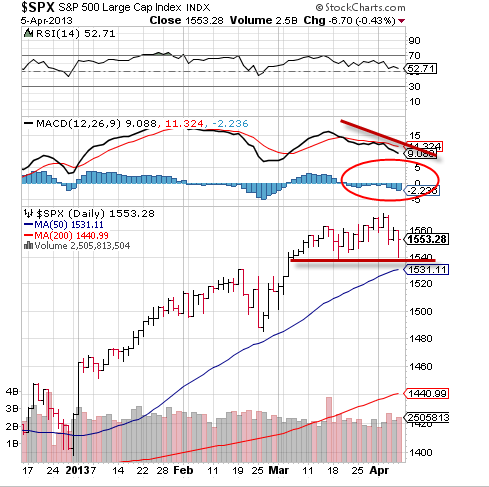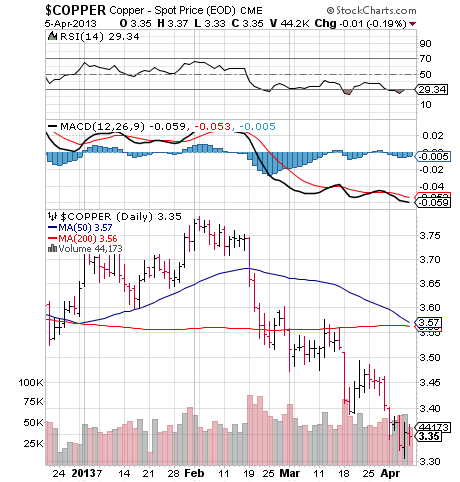The U.S. stock market took a weekly loss as all major U.S. stock indexes posted red weekly numbers.
The Dow Jones Industrial Average (DIA) fell 41 points on Friday to post a negligible 0.1% decline for the week while the S&P 500 (SPY) dropped 0.43% on Friday and lost 1% for the week.
The Nasdaq Composite (QQQ) slipped 0.66% on friday and 2% for the week while the Russell 2000 (IWM) dropped 0.25% on Friday and 1.7% for the week.
On My ETF Radar

In the chart of the S&P 500 (SPY) above, we can see how the index peaked at all time highs and now has slipped into a short term declining trend. Momentum as represented by MACD is in decline and on a “sell” signal and recent action has brought the index to major support levels at 1540. Further support rests at 1520-1530 and 1500.
Market internals continue to weaken and cross market indicators show further weakness as bonds (IEF) rally and “Dr. Copper,” (JJC) often viewed as a bell whether for future economic activity, continues its slump. 

ETF News You Can Really Use
It was a wild week in global markets as the Bank of Japan “doubled down” on its bond buying program as the debt ridden country continues tryint to shake off nearly two decades of deflation. The Japanese Yen (JPY) collapsed on the move, dropping 4% in two days while the Nikkei spiked 6.9%.
In Europe, Cyprus continues its recovery from the recent banking crisis and the continent looked towards Mario Draghi for more central bank support for the region. The Eurodollar (FXE) gained for the week.
At home, the big news was Friday’s disastrous Non Farm Payrolls report which showed the U.S. economy adding a paltry 88,000 jobs in March, a huge miss on expectations of 190,000 and last month’s 268,000. Most analysts suggest that the U.S. economy needs to generate 100,000 new jobs/month just to keep unemployment steady and so this report comes as a huge disappointment to U.S. policy makers and financial markets.
In good economic news, construction spending was up and beat expectations and factory orders expanded at 3.0% for February versus last month’s -1.0%.
But for the week, the economic news was overwhelmingly negative as Markit PMI declined to 54.6 in March, ISM Manufacturing fell to 51.3 from 54.2 and missed expectations, ISM Non Manufacturing dropped to 54.4 on another miss and weekly jobless claims climbed to 385,000.
Other developing stories and potential problems come from the ongoing sabre rattling by North Korea and the bird flu outbreak in China which drove the Shanghai Composite down 3.2% on the week.
Next week brings important economic news in the form of the FOMC minutes which will be parsed for clues as to the Federal Reserve’s stance on continued easing, weekly jobless claims and Friday will be the big day with March retail sales, producer price index and consumer sentiment.
Bottom line: Fundamentals continue to weaken in spite of the herculean efforts of the Federal Reserve, Bank of Japan and European Central Bank. Technical indicators also signal caution and the bond market signals an underlying trend of “flight to safety” in spite of recent record inflows into U.S. mutual funds and stock market. Macro risk remains high for global financial markets.
Disclaimer: The content included herein is for educational and informational purposes only, and readers agree to Wall Street Sector Selector’s Disclaimer, Terms of Service, and Privacy Policy before accessing or using this or any other publication by Wall Street Sector Selector or Ridgeline Media Group, LLC.
- English (UK)
- English (India)
- English (Canada)
- English (Australia)
- English (South Africa)
- English (Philippines)
- English (Nigeria)
- Deutsch
- Español (España)
- Español (México)
- Français
- Italiano
- Nederlands
- Português (Portugal)
- Polski
- Português (Brasil)
- Русский
- Türkçe
- العربية
- Ελληνικά
- Svenska
- Suomi
- עברית
- 日本語
- 한국어
- 简体中文
- 繁體中文
- Bahasa Indonesia
- Bahasa Melayu
- ไทย
- Tiếng Việt
- हिंदी
Weekly Loss For US Stock Market, Poor Economic Reports
Published 04/08/2013, 12:48 AM
Updated 05/14/2017, 06:45 AM
Weekly Loss For US Stock Market, Poor Economic Reports
U.S. stock market takes weekly loss on poor economic reports.
3rd party Ad. Not an offer or recommendation by Investing.com. See disclosure here or
remove ads
.
Latest comments
Install Our App
Risk Disclosure: Trading in financial instruments and/or cryptocurrencies involves high risks including the risk of losing some, or all, of your investment amount, and may not be suitable for all investors. Prices of cryptocurrencies are extremely volatile and may be affected by external factors such as financial, regulatory or political events. Trading on margin increases the financial risks.
Before deciding to trade in financial instrument or cryptocurrencies you should be fully informed of the risks and costs associated with trading the financial markets, carefully consider your investment objectives, level of experience, and risk appetite, and seek professional advice where needed.
Fusion Media would like to remind you that the data contained in this website is not necessarily real-time nor accurate. The data and prices on the website are not necessarily provided by any market or exchange, but may be provided by market makers, and so prices may not be accurate and may differ from the actual price at any given market, meaning prices are indicative and not appropriate for trading purposes. Fusion Media and any provider of the data contained in this website will not accept liability for any loss or damage as a result of your trading, or your reliance on the information contained within this website.
It is prohibited to use, store, reproduce, display, modify, transmit or distribute the data contained in this website without the explicit prior written permission of Fusion Media and/or the data provider. All intellectual property rights are reserved by the providers and/or the exchange providing the data contained in this website.
Fusion Media may be compensated by the advertisers that appear on the website, based on your interaction with the advertisements or advertisers.
Before deciding to trade in financial instrument or cryptocurrencies you should be fully informed of the risks and costs associated with trading the financial markets, carefully consider your investment objectives, level of experience, and risk appetite, and seek professional advice where needed.
Fusion Media would like to remind you that the data contained in this website is not necessarily real-time nor accurate. The data and prices on the website are not necessarily provided by any market or exchange, but may be provided by market makers, and so prices may not be accurate and may differ from the actual price at any given market, meaning prices are indicative and not appropriate for trading purposes. Fusion Media and any provider of the data contained in this website will not accept liability for any loss or damage as a result of your trading, or your reliance on the information contained within this website.
It is prohibited to use, store, reproduce, display, modify, transmit or distribute the data contained in this website without the explicit prior written permission of Fusion Media and/or the data provider. All intellectual property rights are reserved by the providers and/or the exchange providing the data contained in this website.
Fusion Media may be compensated by the advertisers that appear on the website, based on your interaction with the advertisements or advertisers.
© 2007-2024 - Fusion Media Limited. All Rights Reserved.
